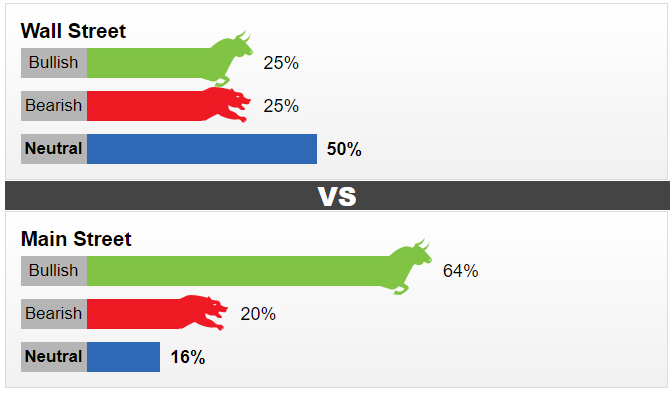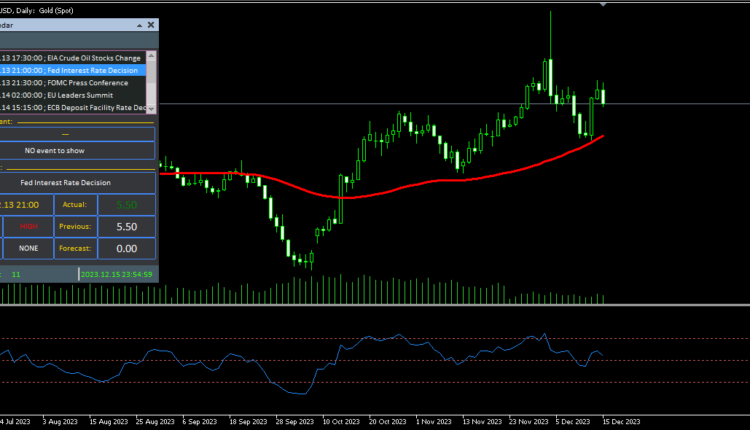Gold rise or stop?! – Analytics & Forecasts – 17 December 2023
If you open the chart of the global gold ounce and go to the daily timeframe, you will see that in the past week, it has been able to play the role of a strong support for gold by opening at around $1975, which is where the 50-day moving average has been for a long time. On Tuesday, the market went up slightly and then fell again to around $1977 due to bearish pressure.
Gold was able to climb up not only above the $2000 level but also up to around the important $2050 level during Wednesday and thursday due to weak economic reports and dovish decisions by Federal Reserve officials.
Last week's events of gold in the forex market:
Last Monday, December 11th, 2023, the global gold ounce, which had started its day and week at $2004, fell to around the important $1975 level. The biggest reason for this decline was the very important Non-Farm Payrolls (NFP) report released on that same day.
According to the latest reports from the US Bureau of Labor Statistics (BLS), it was revealed that non-farm payrolls in the US increased by 199,000 in November. This number was higher than both the 150,000 reported in the previous month and the predicted 180,000. Other details of this report showed that the unemployment rate decreased from 3.9% to 3.7% during this period, while the annual wage inflation measured by changes in average hourly income remained at a steady rate of 4%.
Finally, the labor force participation rate increased from 62.7% to 62.8%, and immediately after the release of this report, the US dollar index gained strength and became stronger against its competitors. As a result, the global gold price began to decline and moved in the opposite direction of the dollar's upward trend.
Then came Tuesday, the day when the market was waiting for an important report on the US Consumer Price Index (CPI). As you know, the CPI is one of the most significant drivers affecting the market and financial assets such as gold and the dollar. The Federal Reserve officials always consider it in their decisions.
The US Bureau of Labor Statistics reported that the US inflation rate, which is determined by changes in consumer prices, decreased by 3.1% in November. It is worth noting that this figure was announced following October's 3.2% figure, which was exactly in line with analysts' predictions.
Furthermore, the annual net inflation rate, or Core CPI, which excludes food and energy, was also announced at the same 4% figure.
The monthly and net monthly inflation rates were also announced at 0.1% and 0.3%, respectively.
Then Wednesday came, the same day that the market was waiting for the important CPI, when the forecasts had announced the figure of 0.2, but the same previous figure was announced as 0.
In addition, the monthly producer price index, which was -0.4, was declared zero, just as predicted.
It is important to know that the dollar and gold did not react to this report, and the reason was that the entire market was waiting for the meeting of the Central Bank of America officials.
The important factor that caused the flight of gold prices was the dovish statements by Federal Reserve officials regarding the start of the interest rate reduction process. Policymakers not only signaled the end of contractionary policies or interest rate hikes but also announced that the Federal Reserve intends to reduce interest rates three times, or 75 basis points, in 2024.
Federal Reserve Chairman Jerome Powell announced that he and his colleagues have successfully achieved their goal of reaching a 2% inflation rate and will do so without causing a recession. This statement and decision by Federal Reserve officials caused the 10-year Treasury bond yield to drop from 4.21% to 3.94%, causing the value of the US dollar index to fall to around 102.43, its lowest level in the past four months. Powell added that his colleagues are discussing and considering the timing of starting to reduce interest rates and that what is very important to us is Don't make the mistake of keeping interest rates high for too long.
On Thursday, the market was eagerly awaiting important central bank meetings of Switzerland, England, and Europe, but as predicted, no significant changes or events occurred, and rates remained unchanged. The biggest difference between the Bank of England and the Federal Reserve was the tone of their presidents. Unlike Federal Reserve Chairman Andrew Bailey, Bank of England Governor Mark Carney stated that due to persistent inflation, we are likely to keep interest rates high for a longer period. Carney's tone was perceived as hawkish by the market and caused the pound to strengthen against the dollar.
After the important decisions of the central banks of Switzerland, England, and Europe, gold continued its upward trend to around the important $2050 level. On Thursday, the market was waiting for retail sales and weekly jobless claims reports from the US. All of these reports were better than economists' predictions and caused the dollar to strengthen in the market. For example, net retail sales in the US, which were predicted to drop from zero to negative one percent, surprisingly increased by two percent. The weekly jobless claims report, which was expected to decrease from 221 to 219, surprisingly announced a decrease of 202,000.
Finally, the last working day of the week arrived, and the only important report for the dollar and gold was the Purchasing Managers' Index (PMI) for services and production, which was better for the former and worse for the latter than market predictions.
there will be no significant news for the dollar and gold on Monday, December 18th. The only important news on Tuesday will be the release of Canada's Consumer Price Index (CPI). On Wednesday, the market will be waiting for the UK's CPI report and the US Conference Board Consumer Confidence Index. Thursday will bring important news for the US, including the final Gross Domestic Product (GDP) report and the weekly jobless claims report. Finally, on the last working day of the week, the market will be waiting for the important Personal Consumption Expenditures (PCE) report for the US. It is expected to be a quiet week with little volatility.
Weekly Technical Analysis of Gold:
If you take a look at the daily gold chart, you'll see that last week's price floor was $1,973 and its ceiling was $2,047. The global gold ounce rose about 0.75% last week, bringing joy to market bulls.
The RSI indicator on the daily timeframe is currently trending down towards the key level of 50 and showing a value of 53. This suggests that gold has lost its upward momentum and further corrections are not unexpected.
Important support levels for gold:
If gold starts to decline, its first important support level will be $2,010. If market bears push it below this level, the next important support level will be $1,990. Finally, if gold falls below this level, the next critical support level will be $1,970.
Important resistance levels for gold:
If gold increases in value, its first important resistance level will be $2,040. If market bulls push it higher than this level, the next important resistance level will be $2,060. Finally, if gold surpasses this level as well, the next critical resistance level will be $2,080.
Finally, we have compiled some statistics from Wall Street analysts for you:
This week, 12 analysts participated in a survey on gold. three experts (25%) predicted an increase in gold prices for the coming week, while three other analysts (25%) predicted a decrease in prices. The remaining six analysts (50%) were neutral on gold for the upcoming week.
Market analysts have varying opinions on the outlook for gold prices in the upcoming week, but overall, there are balanced indicators with the possibility of an increase in price.

Reasons for optimism:
1. Decrease in the value of the dollar and decrease in bond yields: These two factors traditionally help increase the price of gold.
2. Seasonal demand: From Christmas to Valentine's Day, there is high demand for physical gold, which can help increase its price.
3. Central bank purchases: Central banks continue to buy gold, which can have a positive impact on its price.
4. Market expectations: Many market participants expect the Federal Reserve to lower interest rates in the near future, which can also help gold.
Reasons for caution:
1. Contradictory statements from the Federal Reserve: Some Federal Reserve officials have made conflicting statements about monetary policies, which can create uncertainty in the market.
2. Possible strengthening of the dollar: The US dollar index may strengthen in the short term, which can put pressure on gold prices.
3. Short-term correction: The recent upward trend in gold prices may experience a short-term correction.
Conclusion:


Comments are closed.